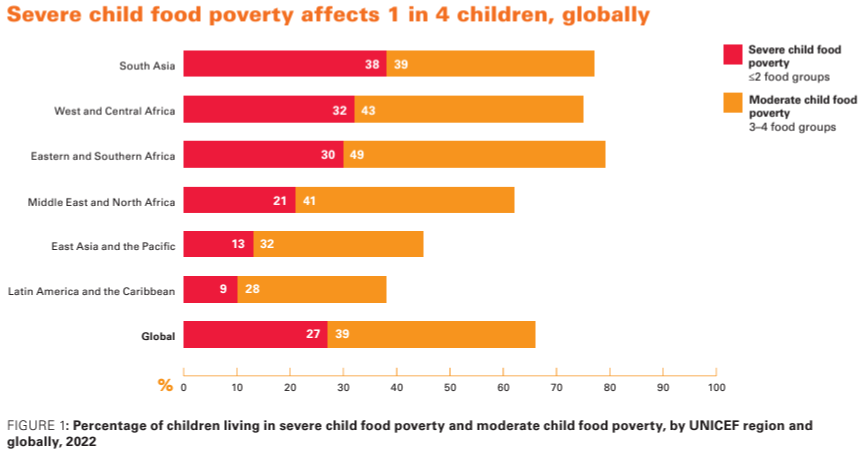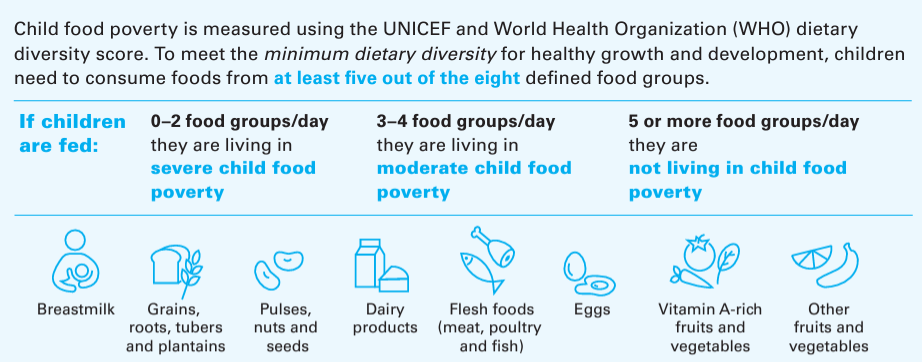Child Nutrition Report, 2024
Relevance: GS Paper II
Why in the News?
A recent UNICEF report on child nutrition should cause serious concern over the impact of malnutrition on children’s health all over the world, especially in India.
- According to the Child Nutrition Report 2024, 181 million children under five live in severe food poverty globally. India, China, Afghanistan, Bangladesh, and Pakistan account for 65% of them.

What is child food poverty?
- UNICEF has introduced the concept of child food poverty to bring dietary deprivation and poor-quality diets in early childhood to the forefront of global efforts to achieve the Sustainable Development Goal (SDG) nutrition targets for children under 5 years of age.
- UNICEF defines child food poverty as children’s inability to access and consume a nutritious and diverse diet in early childhood.

Key findings of the report:
- Finding 1: Globally, one in four children (27 per cent) are living in severe child food poverty in early childhood, amounting to 181 million children under 5 years of age.
- Severe child food poverty affects all regions of the world, but not equally: South Asia and sub-Saharan Africa are home to more than two-thirds (68 per cent) of the 181 million children living in severe child food poverty.
- Twenty countries account for almost two-thirds (65 per cent) of the total number of children living in severe child food poverty: Afghanistan, Bangladesh, China, Côte d’Ivoire, the Democratic Republic of the Congo, Egypt, Ethiopia, Ghana, India, Indonesia, Myanmar, the Niger, Nigeria, Pakistan, the Philippines, Somalia, South Africa, Uganda, the United Republic of Tanzania and Yemen.

- Finding 2: Globally, progress towards ending severe child food poverty is slow, but some regions and countries are proving that progress is possible and is happening.
- In the subset of 64 countries with trend data, the percentage of children living in severe child food poverty decreased minimally during the last decade (34 per cent in 2012 to 31 per cent in 2022); the prevalence did not change in 32 countries and increased in 11 countries.
- However, in West and Central Africa, severe child food poverty fell by one quarter (42 per cent to 32 per cent).
- Twenty-one countries – about one in three of the 64 countries with trend data – achieved a significant reduction in severe child food poverty.
- Finding 3: Severe child food poverty is experienced by children belonging to poor and non-poor households, indicating that household income is not the only driver of child food poverty.
- Of the 181 million children living in severe child food poverty, about half (84 million, or 46 per cent) belong to households in the two poorest wealth quintiles, among whom limited household income is likely to be a major driver of severe child food poverty.
- The remaining 97 million children (54 per cent) living in severe child food poverty belong to households in the middle and two upper wealth quintiles, among whom factors other than income poverty are driving the problem.
- Finding 4: Children living in severe child food poverty are missing out on many nutrient-rich foods, while unhealthy foods are becoming entrenched in their diets.
- Among children living in severe child food poverty, four out of five are fed only breastmilk and/or dairy products and/or a starchy staple, such as rice, maize or wheat.
- Less than 10 per cent are fed fruits and vegetables and less than 5 per cent are fed eggs, or meat, poultry and fish.
- Meanwhile, unhealthy foods and beverages are consumed by an alarming proportion of children living in severe child food poverty, displacing more nutritious foods from their diets.
- In Nepal, for example, 42 percent of children living in severe child food poverty consume foods high in sugar, salt and/or fat, and 17 per cent consume sweet beverages.
- Finding 5: The global food and nutrition crisis and localized conflicts and climatic shocks are intensifying severe child food poverty, especially in fragile and humanitarian settings.
- Since 2020, the economic fall-out of the COVID-19 pandemic, the war in Ukraine and localized conflicts and climatic shocks have exacerbated the challenges that parents and families face in feeding their children.
- In vulnerable communities in the Democratic Republic of the Congo and Somalia, more than 80 per cent of parents reported that their child had been unable to eat for an entire day because of a lack of money or other resources.
- One in three children in fragile countries are living in severe child food poverty. For children in extremely fragile contexts, the percentage affected by severe child food poverty can soar to exceptionally high levels, such as in Afghanistan (49 per cent), Somalia (63 per cent), and most recently in the Gaza Strip in the State of Palestine (nine in ten children living in severe child food poverty between December 2023 and April 2024).
- Finding 6: Severe child food poverty is driving child undernutrition: the percentage of children living in severe child food poverty is three times higher in countries with a high prevalence of stunting.
- Severe child food poverty is associated with child undernutrition. One in three children (32 per cent) experience severe child food poverty in countries with a high prevalence of stunting, compared to 11 per cent in countries with a low prevalence, and the odds of stunting are 34 per cent higher in children affected by severe child food poverty compared to children who are not affected.
- Similarly, the percentage of children living in severe child food poverty is more than double in countries with a high compared to the low prevalence of wasting (35 per cent versus 14 per cent), and the odds of wasting are 50 per cent higher if a child is affected by severe child food poverty.
The forces driving severe child food poverty:
The analysis identifies three major drivers of severe child food poverty: poor food environments for children, poor feeding practices in early childhood, and household income poverty affecting children and their families.

Recommendations to end severe child food poverty:
- Position child food poverty elimination as a policy imperative and child food poverty reduction as a metric of success towards achieving global and national nutrition and development goals, with time-bound targets and results in relevant sectoral and multisectoral plans.
- Transforming food systems by ensuring food environments make nutritious, diverse, and healthy foods the most accessible, affordable, and desirable option for feeding young children and that the food and beverage industry complies with policies and regulations to protect children from unhealthy foods and beverages.
- Leverage health systems to deliver essential nutrition services to prevent and treat child malnutrition – including community-based counselling, support and services to improve feeding and care practices in early childhood – prioritizing the most vulnerable children.
- Activate social protection systems to address income poverty in ways that are responsive to the food and nutrition needs of vulnerable young children and their families, including social transfers (cash, vouchers and food) to protect children at the highest risk of child food poverty.
- Strengthen data systems to assess the prevalence and severity of child food poverty and identify its drivers; detect increases in child food poverty early, including in fragile and humanitarian contexts; and track national and global progress in reducing severe child food poverty.
Conclusion:
To make freedom from severe child food poverty a reality for all children – including the most vulnerable – governments, together with development and humanitarian organizations, civil society and media, academia and research organizations, and the food and beverage industry must urgently commit to a bold and broad response. Crucially, these stakeholders must hold themselves and each other accountable for delivering on commitments to transform, leverage and activate the food, health and social protection systems and strengthen data systems to track progress in reducing severe child food poverty.


